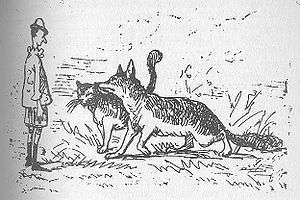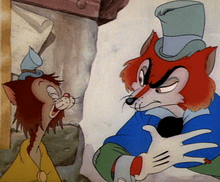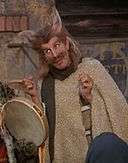The Fox and the Cat
| The Fox and the Cat | |
|---|---|
| The Adventures of Pinocchio characters | |
 The Fox and the Cat, as drawn by Enrico Mazzanti | |
| First appearance | The Adventures of Pinocchio |
| Created by | Carlo Collodi |
| Information | |
| Species |
Fox (The Fox) Cat (The Cat) |
| Gender | In Collodi's story and in most adaptation of the story they are both portrayed as male characters; in the 2012 film, the Fox is female |
The Fox and the Cat (Italian: Il gatto e la volpe, the names sequence is reversed as gatto means "cat" and volpe means "fox") are a pair of fictional characters who appear in Carlo Collodi's book The Adventures of Pinocchio (Le avventure di Pinocchio). Both are depicted as con-men, who lead Pinocchio astray and unsuccessfully attempt to murder him.[1][2] The pair pretend to sport disabilities; the Fox lameness and the Cat blindness. The Fox is depicted as the more intelligent of the two, with the Cat usually limiting itself to repeating the Fox's words.
Role in the book
Pinocchio encounters the two after leaving Mangiafuoco's theatre with five gold coins, whereupon the Fox claims to know Pinocchio's father Mister Geppetto and proposes to Pinocchio to visit the Land of Barn Owls (Paese dei Barbagianni) and thence to a 'Field of Miracles' (Il campo dei Miracoli), where coins can be grown into a money-producing tree. A white blackbird warns Pinocchio against these lies, but is eaten by the Cat. The Fox covered up this action by claiming that the blackbird talks too much. The pair lead Pinocchio to the Red Prawn Inn (Osteria del Gambero Rosso), where they eat a large meal and ask to be awoken at midnight.
Two hours before the set time, the pair abandon Pinocchio to pay for the meal with one of his coins and has the innkeeper leave a message for Pinocchio that the Cat's eldest kitten had fallen ill, and that they would meet Pinocchio at the Field of Miracles later. When Pinocchio leaves the inn, the two attack him in disguise of murderers, and in the ensuing struggle, Pinocchio bites off the Cat's paw. The murderers then hang Pinocchio from a tree, which he escapes with the assistance of The Fairy with Turquoise Hair who enlisted a falcon to cut him down.
The next day, Pinocchio encounters the pair again unaware that they are the murderers that hung him. When Pinocchio notices the Cat's paw in a sling, the Fox claims that the Cat cut it off to feed a starving wolf. They lead Pinocchio to the town of Catchfools (Acchiappa Citrulli), where the coins are soon buried. In Pinocchio's absence, the pair dig up the coins and escape. Pinocchio learned of this from a parrot who mocked him for falling for their tricks.
Near the end of the book, Pinocchio encounters the Fox and the Cat again when looking for a place for Geppetto to recuperate. This time, the pair have become impoverished, whereas the Fox is now truly lame, nearly hairless, and tailless (the Fox had to chop off his own tail to sell for money), and the Cat truly blind. They plead for food or money, but are rebuffed by Pinocchio (having learned of their tricks and presumably realizes that they were the ones who tried to murder him) while stating that it serves them right for their wickedness. He then leaves, all the while saying goodbye to his "false friends."
Portrayals in popular culture
In Disney media

In the 1940 Disney film Pinocchio, the Fox and the Cat are given the names John Worthington Foulfellow or "Honest John" (voiced by Walter Catlett) and Gideon (whose three hiccups were provided by Mel Blanc).[3][4][5][6][7][8] The pair differ from their original counterparts in a number of ways; they do not feign disability, and it is they who persuade Pinocchio to join Stromboli's puppet show and coax him to go to Pleasure Island, upon being hired by The Coachman. However, upon hire, Foulfellow and Gideon are frightfully concerned with the Coachman's proposition of luring children to Pleasure Island as it is deemed off limits by the authorities and again, when the Coachman reveals the reason for his plan, along with his face changing to include more sinister features.[9] Apart from his three hiccups, Gideon is mute. Though portrayed as scoundrels, they never go as far as attempting to murder Pinocchio, although Honest John suggests strongly to the Coachman that they will if that's the proposed job. The subplot of the Field of Miracles is absent. The villains' ultimate fate is that they are arrested by the police when they encounter Pinocchio a third time in some way, but the scene in which this occurred ended up being deleted from the final draft of the film. Foulfellow is portrayed as an eccentric ham actor whereas Gideon's mannerisms resemble Harpo Marx of the Marx Brothers It was up for consideration to use the characters again in the 1947 Disney film Fun and Fancy Free as the owners of the Magic Beans Mickey Mouse acquires in exchange for his cow, but the idea was dropped.[10]
The duo were set to make an appearance in the 2009 RPG video game Kingdom Hearts 358/2 Days but were cut for space restrictions.
In the Disney book Pinocchio's Promise, Foulfellow and Gideon see Pinocchio walking into town to give a cuckoo clock to Gepetto's friend Mrs. Ramono whereupon he is diverted to a circus. Foulfellow attempts to sell the clock elsewhere while Gideon takes Pinocchio to the circus with two expired tickets, but abandons the boy when the latter is scolded by the admission attendant. Pinocchio reports Foulfellow's trickery to the local police. Foulfellow and Gideon are arrested by the police and Pinocchio gives the clock to Mrs. Ramono.
In a Disney book adaption of the tale The Emperor's New Clothes, the two, posing as tailors, trick the emperor (portrayed in the same book by Prince John).
In other media
- In the 1960–61 television adaptation by Rankin/Bass Productions, The New Adventures of Pinocchio, the Fox and the Cat are named Foxy Q. Fibble and Cool S. Cat. These characters are voiced by Larry D. Mann and Paul Kligman.
- The Fox and the Cat appear in the 1972 miniseries The Adventures of Pinocchio, portrayed by Ciccio Ingrassia and Franco Franchi. They are depicted as humans but with fur, whiskers and pointy ears.

- In Giuliano Cencis's 1972 adaptation of Pinocchio, the Fox and the Cat (voiced by Sergio Tedesco and Manlio De Angelis in the Italian version and by Alan Sues and Don Messick in the English dub) follow the characterization shown in the book: the pair pretend to be physically disabled, and tempt Pinocchio to the Field of Miracles. As in the book, the Fox is the more articulate of the two, and the Pair attempt to murder Pinocchio for his coins, though the Cat does not lose his paw as in the book. At the end of the film, the two are impoverished, though the Fox does not lose his tail or any of his fur as in the book.
- The Fox and the Cat are the primary antagonists of another Rankin/Bass adaptation in 1980, Pinocchio's Christmas, voiced by Allen Swift (who was impersonating Sydney Greenstreet) and Pat Bright. They had previously made "friends" with Pinocchio and taught him many of his bad habits. They do not feign disability and the Cat is female. They try to sell Pinocchio to a sleigh driver that works for a rich duke who will give Pinocchio to his children. They aren't seen again after they give Pinocchio to a servant of the Duke.
- In the 1992 direct to video adaptation entitled Pinocchio from GoodTimes Entertainment, the Fox is replaced with a Wolf, the Cat speaks like a beatnik, and both are voiced by Cam Clarke. The two of them target Pinocchio's gold coins and have not attempted to kill Pinocchio. At the film's conclusion, the Wolf and the Cat are arrested by a police officer when Pinocchio sees them in a passing paddy wagon. They beg Pinocchio to vouch for them whereupon Pinocchio tells the police officer that they stole his coins. The police officer then drives the paddy wagon away stating that what they did to Pinocchio will be the result of a long prison sentence.
- In Steve Barron's 1996 live action film The Adventures of Pinocchio, the Fox and the Cat (portrayed by Rob Schneider and Bebe Neuwirth) are named Volpe ('Fox' in Italian) and Felinet, and are portrayed as human thieves in league with Mangiafuoco (named Lorenzini in this adaptation). In a reversal of roles, Felinet is female (although this is the case in the book) and takes on the more dominant role while Volpe is a bungling sidekick. They first appear at their first encounter with Pinocchio, from which Geppetto takes Pinocchio away from them while telling Volpe and Felinet that Pinocchio will play with his own sort. Volpe and Felinet later witness Pinocchio causing mischievous havoc in a bakery even when the police arrive. As in the novel, the pair trick Pinocchio into giving up his coins by taking him to the Field of Miracles (depicted near a monastery), where they steal the money. In conclusion, they are tricked by Pinocchio into drinking cursed water (where Pinocchio claims that the water will enable them to turn white stones into gold) which transforms them into a real fox and cat offscreen. They are shown to have been captured by a farmer and kept as pets where they later witness Pinocchio in town. When Volpe quotes "Don't you just hate that kid," Felinet quotes "Not as much as I hate you."
- The Fox and the Cat were featured in the Happily Ever After: Fairy Tales for Every Child version of Pinocchio where they were referred to as Redd Foxx (voiced by Barry Douglas) and Sporty the Cat (voiced by Franklyn Ajaye).
- The Fox and the Cat were featured in the 2002 film Pinocchio where they were played by comedy duo Fichi d'India (Bruno Arena and Max Cavallari) in the Italian version and their English-dubbed voices were provided by Cheech Marin and Eddie Griffin. Like some of the animal characters depicted in this film, this version are depicted as humans but sport pointy ears and fangs. They trick Pinocchio into digging his coins in the Meadow of Miracles outside of Grabadimwit. They are not seen again after seizing Pinocchio's coins.
- In Pinocchio 3000, the characters Cab and Rodo (voiced by Matt Holland and Jack Daniel Wells) are two robots based on the Fox and the Cat. They are owned by Mayor Scamboni's daughter Marlene.
- The Fox and the Cat appear in the 2008 TV film Pinocchio, portrayed by Toni Bertorelli and Francesco Pannofino.
- The Fox and the Cat appear in the 2012 Pinocchio film, voiced by Mariccia Affiato and Maurizio Micheli in the Italian version and by Sonja Ball and Thor Bishopric in the English dub. In this version, the Fox is female and the Cat is male.
Notes
Often the Field of the miracles has been mistaken with the poetic phrase Square of the miracles that is used since the second half of the 20th century to describe the Piazza del Duomo of Pisa. The monuments of the famous square had been called miracles by Gabriele D'Annunzio in his book Forse che sì, forse che no (1910). Several famous squares in Italy being called campo and the story of Pinocchio being widespread in the World, many people, in and outside Italy, tend to confuse the two.
References
- ↑ Roberts, Hannah (2013-11-12). "Villa that inspired Pinocchio goes for sale for £9m". Dailymail.co.uk. Retrieved 2015-07-01.
- ↑ Rich, Nathaniel (2011-10-24). "Carlo Collodi's Pinocchio: Why is the original Pinocchio subjected to such sadistic treatment?". Slate.com. Retrieved 2015-07-01.
- ↑ "Animated Films - Virgin Film - James Clarke". Books.google.co.uk. 2012-09-30. Retrieved 2015-07-02.
- ↑ "The Disney Fetish - Seán J. Harrington". Books.google.co.uk. Retrieved 2015-07-02.
- ↑ "Who's who in Animated Cartoons: An International Guide to Film & Television ... - Jeff Lenburg". Books.google.co.uk. Retrieved 2015-07-02.
- ↑ "Multiculturalism and the Mouse: Race and Sex in Disney Entertainment - Douglas Brode". Books.google.co.uk. 2009-01-27. Retrieved 2015-07-02.
- ↑ "Functions of the Fantastic: Selected Essays from the Thirteenth ... - Joseph L. Sanders". Books.google.co.uk. Retrieved 2015-07-02.
- ↑ "Disney Theatrical Animated Features - Edited by Paul Muljadi". Books.google.co.uk. Retrieved 2015-07-02.
- ↑ "Handsome Heroes and Vile Villains: Masculinity in Disney's Feature Films - Amy M. Davis -". Books.google.co.uk. 2014-01-31. Retrieved 2015-07-02.
- ↑ "The story behind Fun and Fancy Free", Disney VHS, 1997
Bibliography
- Collodi, Le Avventure di Pinocchio 1883, RCS MediaGroup

